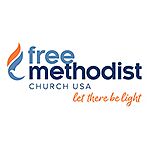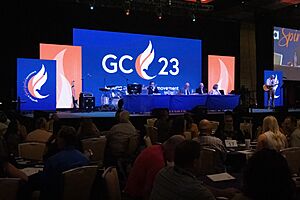Free Methodist Church facts for kids
Quick facts for kids Free Methodist Church |
|
|---|---|

Emblem of the Free Methodist Church USA
|
|
| Classification | Protestant |
| Orientation | Holiness |
| Polity | Modified episcopacy |
| Associations | Christian Holiness Partnership; Christian Churches Together; National Association of Evangelicals; Wesleyan Holiness Consortium; World Methodist Council |
| Region | Worldwide: divided into 13 General Conferences |
| Founder | Benjamin Titus Roberts |
| Origin | 1860 Pekin, New York |
| Separated from | Methodist Episcopal Church |
| Separations | 1932 - Reformed Free Methodist Church 1955 - United Holiness Church (now the Bible Methodist Connection of Churches) 1963 - Evangelical Wesleyan Church 1973 - Fellowship of Independent Methodist Churches |
| Congregations | 856 in the United States (average congregation size: 77) |
| Members | 1,200,797 (68,356 in the United States) |
The Free Methodist Church (FMC) is a Christian church group that follows the Methodist way of believing. It's part of the holiness movement and is based in the United States. It focuses on sharing the Christian message (evangelical) and follows the teachings of John Wesley (Wesleyan–Arminian theology).
This church has members in more than 100 countries around the world. In the United States, there are about 62,516 members. Worldwide, the church has over 1.5 million members. Their official magazine is called Light & Life Magazine. The main office for the Free Methodist Church World Ministries Center is in Indianapolis, Indiana.
Contents
- What is the History of the Free Methodist Church?
- How Many Members Does the Free Methodist Church Have?
- What Do Free Methodists Believe and Practice?
- How is the Free Methodist Church Organized?
- What are Free Methodist World Missions?
- What are the Free Methodist Higher Education Institutions?
- How Does the Free Methodist Church Publish Materials?
- See also
What is the History of the Free Methodist Church?
The Free Methodist Church started in Pekin, New York, in 1860. The people who founded it used to be members of the Methodist Episcopal Church. However, they were asked to leave because they strongly believed in and taught what they felt were the true ideas of John Wesley's Methodism.
A leader named Rev. Benjamin Titus (B. T.) Roberts, who studied at Wesleyan University, helped the church grow quickly. New groups were formed, churches were built, and the work of the church became strong.
Before the church officially began, Roberts started a monthly magazine called The Earnest Christian. Later, in 1868, The Free Methodist magazine began, which is now known as Light & Life. In 1886, a publishing house was created. This place printed books, magazines, and materials for Sunday school.
Why is it Called "Free Methodist"?
The founders kept the name "Methodist" because they felt they were removed from the Methodist Episcopal Church for sticking to the original Methodist beliefs. The word "Free" was chosen for several important reasons:
- The church was against slavery.
- They wanted church seats (pews) to be free for everyone, no matter their wealth or social standing. Many churches at the time sold or rented pews.
- They wanted people to worship freely, guided by the Holy Spirit, instead of having strict, formal services.
- They believed in being completely loyal to Christ, free from secret groups that required special oaths.
- They wanted freedom from unfair decisions by church leaders. This was because 120 clergy and regular members had been unfairly removed from the church.
- They wanted members to experience true "freedom" from the power of sin. This would happen through personal dedication and faith, rather than just trying to manage sin or slowly grow after becoming a Christian.
In 1910, the Methodist Church officially admitted that they had been wrong to treat Benjamin Titus Roberts unfairly 50 years earlier. His original church papers were given back to his son, Rev. Benson Roberts, in a public meeting.
Some groups left the Free Methodist Church over the years. These included the Reformed Free Methodist Church in 1932, the United Holiness Church in 1966, and the Evangelical Wesleyan Church in 1963.
The main offices of the Free Methodist Church were in Winona Lake, Indiana, until 1990. Then, they moved to Indianapolis, Indiana.
What are the Freedoms of the Free Methodist Church?
The Free Methodist Church shared an updated list of their historic "freedoms" for the 21st century. These include:
- Freedom for people of all races to worship together as one.
- Freedom for poor people to be treated with respect in the church and with fairness in the world.
- Freedom for women and men to be treated equally and to use their gifts in the church, at home, and in the world.
- Freedom for regular church members (laity) to be fairly represented in the church's leadership.
- Freedom from any spiritual, political, social, or idea-based groups that might make their loyalty to Jesus Christ less strong.
- Freedom to worship in a way that is inspired and moved by the Holy Spirit.
- Freedom from the power of sin by fully giving oneself to God.
How Many Members Does the Free Methodist Church Have?
As of 2021, the church has about 62,516 members in the United States. Worldwide, its membership is over 1,500,000. Many members live in East Central Africa, in countries like Rwanda, Burundi, and the DRC. There are also many members in other countries.
What Do Free Methodists Believe and Practice?
Free Methodists believe in the standard ideas of Wesleyan-Arminian Protestantism. They especially focus on the teaching of entire sanctification, which means becoming completely holy. This teaching comes from John Wesley, who the Free Methodist Church traces its beginnings to.
The Free Methodist Church, like the United Methodist Church, shares a history connected to the Methodist revival in England during the 1700s. The Free Methodist Church itself grew out of the holiness movement within Methodism in the 1800s.
The first leader, B. T. Roberts, believed that women should be ordained as pastors. He even wrote a book about it called Ordaining Women: Biblical and Historical Insights. His ideas eventually led the church to allow women to be ordained in 1911. By 2008, about 11% of ordained pastors were women.
Free Methodists also allow and train people who are not ordained for special church jobs. They also make sure that regular church members have an equal number of representatives as clergy in church meetings.
Early Free Methodists often sang hymns without instruments during worship. This was partly because some other Methodist churches paid musicians. However, in 1943, the church decided that each local group could choose whether to use instruments. Now, many churches use pianos, organs, and worship teams with singers, drums, and guitars.
How is the Free Methodist Church Organized?
The highest governing body of the Free Methodist Church is the World Conference. This group includes representatives, both regular members and clergy, from all countries that have a Free Methodist General Conference.
As the church grows in each country, its status changes from a Mission District to an Annual Conference, and then to a General Conference. Currently, there are 20 General Conferences around the world. These are connected by their shared beliefs, constitution, the World Conference, and the Council of Bishops.
The Free Methodist Church in the USA is currently led by three bishops: Bishop Keith Cowart, Bishop Kaye Kolde, and Bishop Kenny Martin. Bishop Cowart was first chosen in 2019 and again in 2023. Bishops Kolde and Martin were first chosen in 2023.
What are Free Methodist World Missions?

Free Methodist World Missions oversees church activities in Africa, Asia, Europe, Latin America, and the Middle East. Today, 95% of Free Methodists live outside the United States, and this number is growing.
- International Child Care Ministries (ICCM) is a program that helps children. It supports over 21,000 children in 29 countries. Through education, meals, and medical care, children in need get a chance for a better life. Each child is connected to a local Free Methodist church or ministry.
- Set Free Movement works to stop human trafficking. It brings together faith groups, financial supporters, and other parts of society to end this crime. They create new futures through actions in local communities.
- Volunteers in Service Abroad (VISA) connects volunteers from the Free Methodist Church in the US and UK with Free Methodist World Missions. These volunteers help with ministry work in other countries.
The church currently has ministries in over 88 countries, including:
| Africa | Asia | Europe | Latin America | Middle East | North America |
|---|---|---|---|---|---|
|
|
|
|
|
|
What are the Free Methodist Higher Education Institutions?
B. T. Roberts started what is now Roberts Wesleyan College in 1866. Other colleges followed, including Spring Arbor College (now Spring Arbor University) in 1873, Seattle Pacific University in 1891, and Greenville College (now Greenville University) in 1892. Central College began in 1914.
The following schools are part of the Association of Free Methodist Educational Institutions. The church does not own these schools, but they meet certain requirements to keep this relationship:
- Central Christian College, McPherson, KS
- Greenville University, Greenville, IL
- Roberts Wesleyan University, North Chili, NY
- Spring Arbor University, Spring Arbor, MI
- Seattle Pacific University, Seattle, WA
The Free Methodist Church also helps support Azusa Pacific University in Azusa, CA. Internationally, there is Osaka Christian College in Japan, Hope Africa University in Bujumbura, Burundi, Haiti Providence University, and the Faculdade de Teologia Metodista Livre in São Paulo, Brazil.
Through the John Wesley Seminary Foundation (JWSF), graduate students preparing for full-time ministry in the Free Methodist Church can receive grants or loans at these affiliated schools:
- Asbury Theological Seminary – (KY, FL, TN, OK, CO Campuses)
- Azusa Pacific Seminary, Azusa, CA
- Northeastern Seminary at Roberts Wesleyan College, Rochester, NY
- Portland Seminary at George Fox Evangelical Seminary, Portland, OR
- Seattle Pacific Seminary, Seattle, WA
- Wesley Biblical Seminary, Jackson, MS
- Wesley House of Studies at Baylor University’s Truett Theological Seminary, Waco, TX
- Wesley Seminary at Indiana Wesleyan University, Marion, IN
How Does the Free Methodist Church Publish Materials?
Like John Wesley before him, B. T. Roberts believed it was important for Christians to publish books and other materials.
Before the church was founded in 1860, B. T. Roberts started a monthly magazine called The Earnest Christian. In 1868, The Free Methodist magazine began, which is now called Light & Life Magazine. A publishing house was set up in 1886 to produce books, magazines, and Sunday school materials.
The official publishing group was started by the church at the 1886 General Conference. The church bought the publishing business built by Rev. T. B. Arnold for $8,000. Arnold became the first publisher, and B. T. Roberts was chosen as the editor of The Free Methodist. The Free Methodist Publishing House is also known by its trade name, Light and Life Press.
Audio Publications
In 1944, the Free Methodist Church started a weekly radio show called The Light and Life Radio Hour. It featured hymns, sermons, prayers, and Bible readings. The show ran until 1980.
In 2016, Josh Avery started The FMC Radio Show, which is a podcast. It aims to connect the Free Methodist Church by sharing information about different things happening in the church. Today, the Light+Life podcast shares stories of successful ministries within the Free Methodist Church.
What is the Mission of Light & Life Communications?
Light & Life Communications is the official publishing part of the Free Methodist Church. It is a non-profit organization that works with the church. Its main goal is to publish and share materials that help the church achieve its mission. Light & Life Communications also offers its services and materials to anyone who wants to share the message of Christ.
See also
 In Spanish: Iglesia Metodista Libre para niños
In Spanish: Iglesia Metodista Libre para niños


